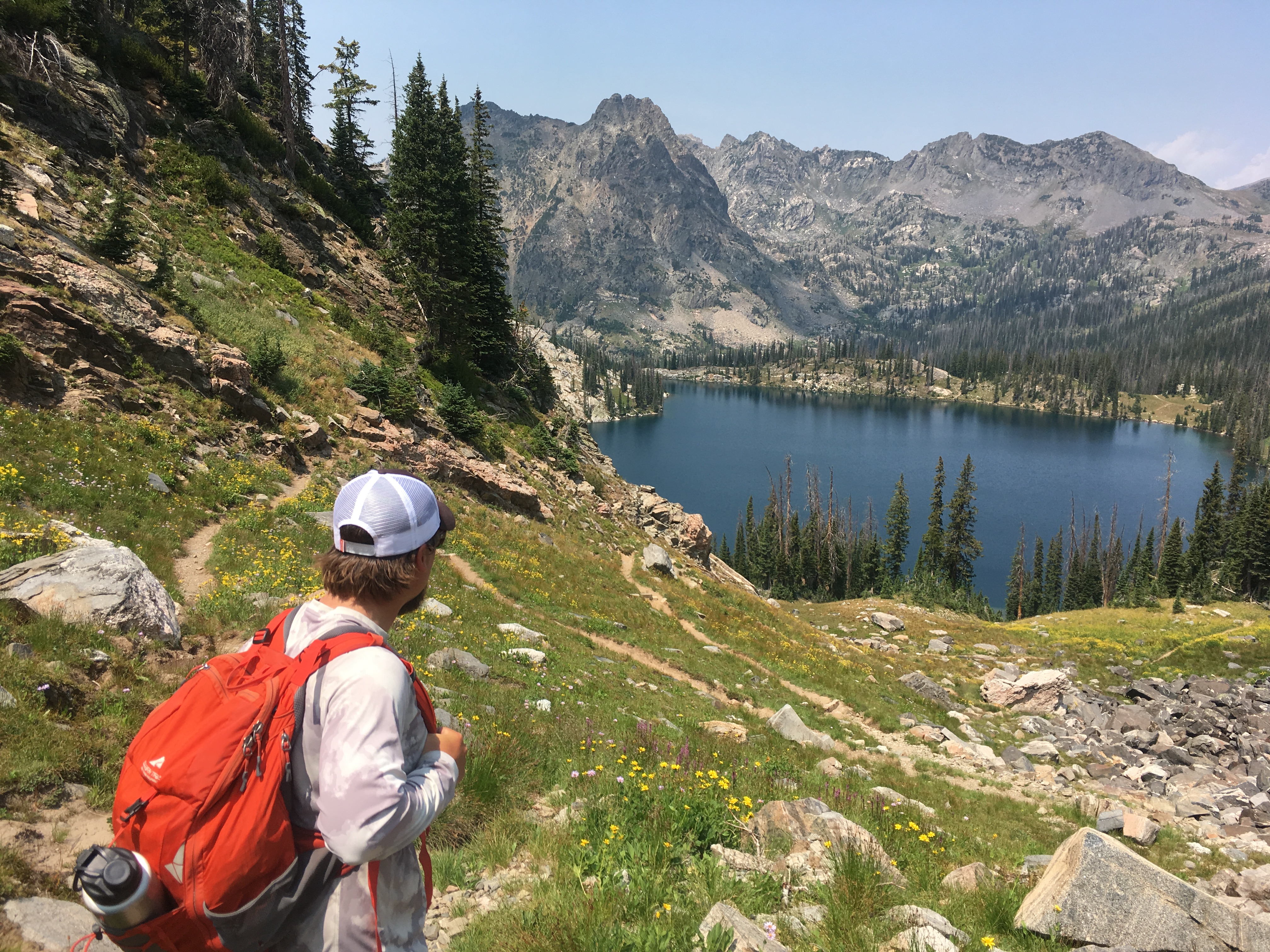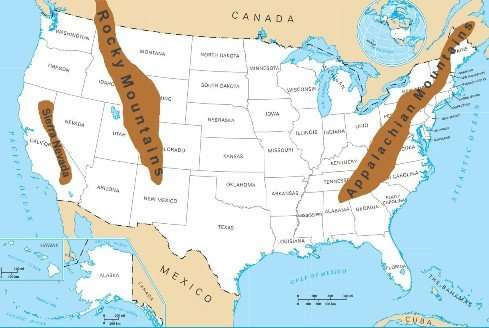This comprehensive guide compares the two mountain ranges in size, location, historical and cultural influence, and the present condition and future outlook of human impacts.
Physical Comparison
| Length | Width | Highest Peak | |
|---|---|---|---|
| Sierra Nevadas | 400 miles | 40-80 miles | 14,505 Mt Whitney |
| Rocky Mountains | 3000 miles | 300 miles | 14,440 Mt Elbert |
About the Author
Gloria worked as a wrangler guiding horseback rides in national forest, wilderness, private ranches, and state lands in Montana, Wyoming, Colorado in the Rocky Mountains, and in California in the Sierra Nevadas.
Location of the Rockies
The Rocky Mountain range spans from Canada all the way down to New Mexico, a 3,000 mile journey. The range extends up to 300 or more miles wide. The highest peak being Mt. Elbert in Colorado at 14,440 feet, just short of the highest in the Sierras.
The Rockies run through states making iconic landscapes, national parks, and world renown views. Starting in Canada it makes up the incredible Banff National Park, which then moves south into Montana creating Waterton- Glacier International Peace Park: the first made international peace park crossing Canada and the US boarder.
The range then is divided into the northern rockies including Montana and Idaho, the middle rockies from Idaho, Wyoming, and Utah making up those infamous ski areas such as Jackson Wyoming and Alta Utah, then the southern rockies in Colorado and New Mexico, making up the iconic Rocky Mountain National Park.
The landscape is incredibly diverse, from flat barren high plateaus, to high jagged peaks. The Rocky Mountains seems alive with open space, conservation and farm lands, massive valleys, wildlife roaming every inch of it, and of course the infamous Yellowstone geysers literally making the land shift and move.
Location of the Sierra Nevada’s
See my post of living in Truckee, California,
The Sierra Nevada Mountain Range extends from northern California down to southern California and out east into Nevada, giving it the name the Sierra Nevadas. A length of 400 miles and a width up to 80 miles, the highest peak being Mt. Whitney at 14,505 feet, a whole 100 feet higher than the height of the Rockies highest peak.
The mountain range includes incredible landscapes from high jagged peaks, many alpine lakes such as Lake Tahoe, massive forested valleys leading up to iconic peaks such as Lassen Volcano and Mt. Shasta, to world class climbing in Yosemite National Park.
My first impression of the Sierra’s mountain range is the incredible forest. The forest here is so dense and thick with an endless coat of evergreens over the hills. The high mountain peaks and ridge lines poke out of the evergreen coat like a head peaking out of the blanket. Towns scatter throughout the steep forest valleys and seem lost in time.
Human History in the Sierra Nevada’s
The Sierra Nevada’s first occupants were nomadic hunter and gathering native american tribes, having little impact on the landscape. In the 1800’s the first European settlers came into the mountain range and began to have an impact, being fur trappers and hunters.
The mid 1800’s the discovery of gold populated the sierra nevadas with prospectors looking to get rich. They settled the area, towns were built up, up by 1900 businesses were booming, mining was at it’s peak in the area, and technology changed the landscape and activities.
Roads were built into the mountains, the train carved its way across jagged landscapes, and people from the populated cities of San Francisco and Sacramento were able to check out the mountains just in their backyard. Not much has changed since then!
History of the Rockies
The Rocky Mountains first inhabitants were Native American Tribes similar to the sierras. Europeans showed up earlier than the sierras, coming in around the 16th century. By the 1800’s, some of the most violent conflict between the europeans and native Americans was seen as the europeans took to settling and exploiting the natural resources that the native Americans lived and relied on.
War broke out everywhere the europeans clashed with native Americans for food supply and territory. There is still tension between Native American tribes today and white people between settlement of land and new laws. Tribes now live on reservations where they govern themselves.
History isn’t as long ago as we sometimes think it is. It is what creates everything we see today and what carved human existence through these incredible landscapes. The rockies are still being exploited for all of its supply of minerals, timber, coal, gold, and other natural resources.
From European fur trappers, hunters, miners, businesses, a booming economy, then crashing of the gold rush to create ghost towns…the human presence in these rocky mountains is violent, eery, and you can feel it when you drive through a ‘ghost town’.
Ghost Town in Montana Rockies
Tourism on the rise
As technology increases, the ability to travel to these areas made tourism incredibly popular. We now exploit and use these mountain ranges making our human impact in many different ways, not just from exploiting natural resources. Roads were built through high mountain passes in both mountain ranges making accessibility to these mountain ranges much easier for city folk from nearby towns.
Business in these small historic mountain towns opened to profit off of tourism. Today with the cheap cost of travel and easy accessibility to get to the mountains from anywhere in the world, we see international tourism in these mountain ranges.
The creation of conservation land, national forests, National parks, and wilderness areas, having thousands of trails to provide recreation has led to mass amounts of mountain tourism. Our human impact is just beginning in the grand scheme of time.
However, with huge mountains, the landscapes rule what creates history and change. Maybe that is why people love the mountains so much. We can’t force change through forces stronger than any human, humbling all of humanity to mother earth.
Recreation in Sierra Nevada vs Rocky Mountain Range Today
Both mountain ranges have:
- Ski mountains packed with tourists from all over the US and the world
- Hiking to high alpine lakes, mountain tops, and lush valleys
- Fishing, boating, kayaking, rafting, and just hanging out in those lakes
- Conservation land, National Parks, National Forests, Wilderness Areas, AKA lots of public land for you to use
- Hunting
- Wildlife, lots of it (maybe more that will kill you in the rockies)
- Tourists (lots of them in well known areas)
- And Not so many people (if you journey away from those well known areas)
The Feel of the Rocky Mountain Range Today
The rocky mountains and the sierras both have so many varied landscapes, but one thing separates the rocky mountains from the sierras. The Rocky mountains FEEL massive. The mountain range is…massive. Montana is nicknamed big sky country for a reason. Even with massive mountain peaks, the land is so vast and spread out by large open valleys, undeveloped that you have a good view of large amounts of sky.
The few and far between scattered towns around the preserved conservation land of the rockies hold its violent and adventurous history. You can feel the pride from the intense adventures and history that it took to build towns in an extreme landscape. Plus, the wildlife you can’t beat in the rockies. There are grizzly bears, mountain lions, and moose to all kill you!
History is still being created in these mountains as thousands of people from around the US move out west to settle the rocky mountains in search for better lives in connect with nature. That makes Colorado specifically a melting pot of people. Colorado feels like southern hospitality because of this melting pot.
Hahns Peak Village, the epitome of a rocky mountain town: history, recreation, and open spaces
The Feel of the Sierra Nevada Range Today
In the sierras, you have an entirely different feel. The land doesn’t feel vast because there aren’t that many open valleys. The forest is thick and healthy with evergreens standing tall and proud, unlike most of the rockies being affected by beetle kill leaving hillsides empty and open.
The space if highly praised and valued by close city folk only a 2 hour drive east or west of the narrow mountain range. The history feels like it was long ago because so many people have been to and explored most of the area in a very short period of time compared to the rockies.
Journey up the country roads of the sierras where no one talks about, you literally feel like you step back into time. One road in and one road out, these small towns are nestled in a steep forested valley, hidden from sky view by tree cover and almost seeming cut off from the rest of advanced technology. The people reflect that, living hippie lives, living off of the land, likely growing weed in these lush mountains.
Future Impacts to the Sierra Nevada Mountains and Rocky Mountains
It’s 2024, politics and technology are changing the way humans interact with the natural environment. I forecast that with the growth of human population, and greater scarcity of natural resources, humans are seeking to be closer to the source. People are moving to higher elevations to escape the heat in humid lower elevation environments. For example, Colorado has seen huge migration of people moving to the state. Wyoming, Montana! All these high elevation, source locations of our most precious resource, WATER.
As a result, high mountain ranges are becoming more accessible. Public lands are being transferred to private hands, roads are being built to access the land. Everything is becoming MORE ACCESSIBLE. The once untouchable locations, such as 14,000foot mountain passes in Colorado, now are labeled as state parks and have ROADS to the top of mountains and over passes. Look out Montana and Wyoming…
However, it is not all grim…People want to protect out natural areas and limit access by humans… But does it do just that, or does it accomplish the opposite? At least we can all agree that the beauty of these places must be preserved. How is the question.




Leave a Reply